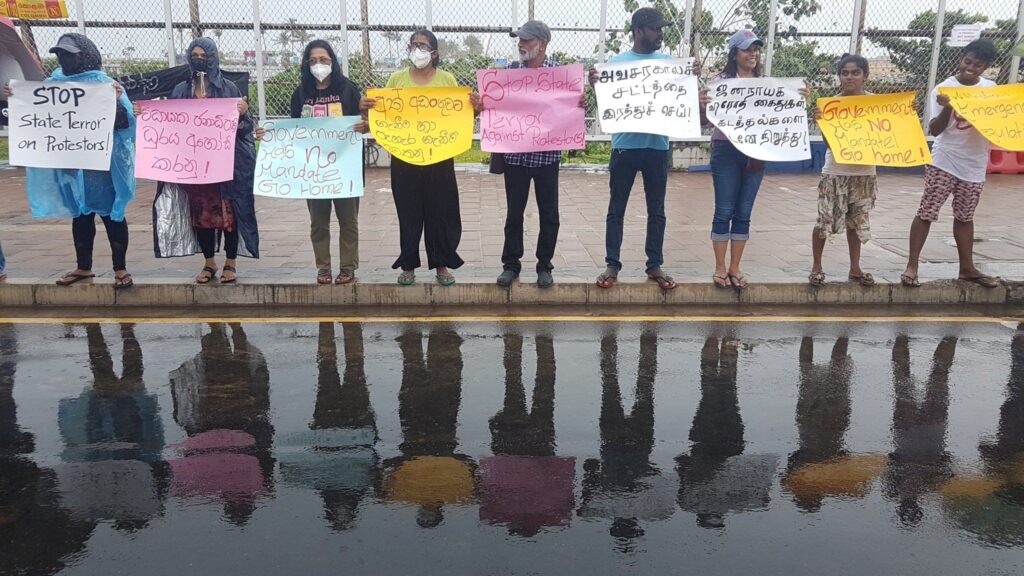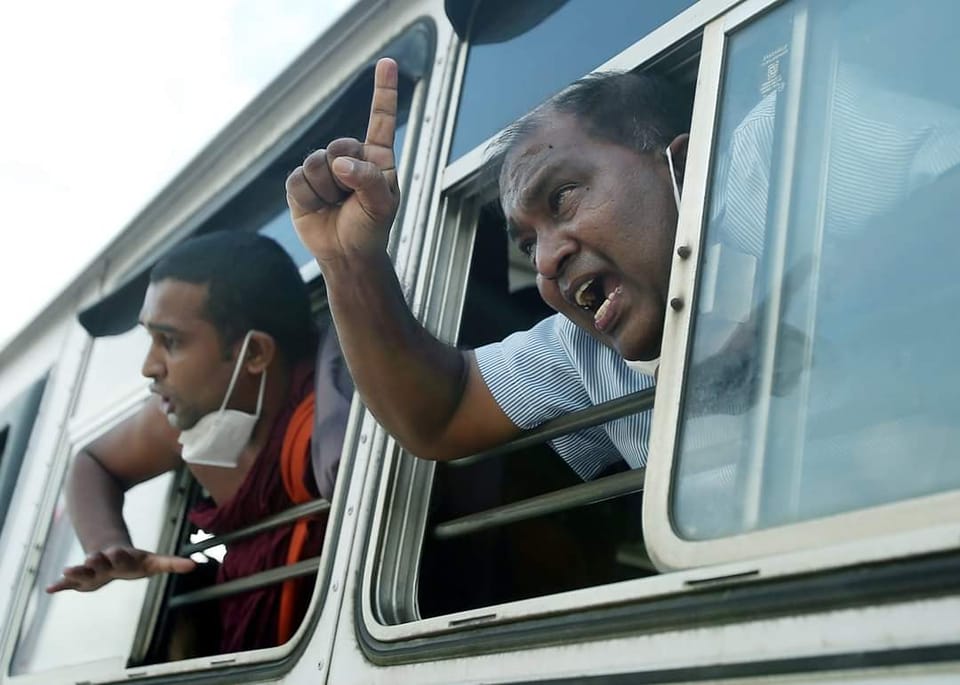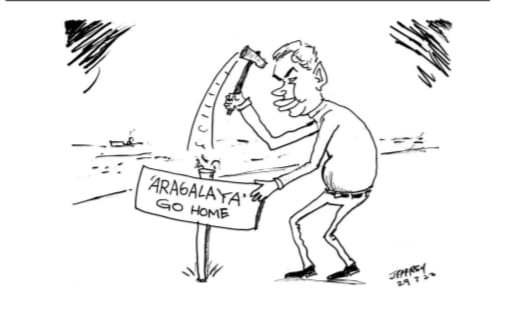by Nillanthan Maha on his blog, August 6, 2022
[translated with Google with edits]

General Sarath Fonseka had warned that people would take to the streets on the coming ninth day. It seems that the people did not accept what he said. There was an allegation that Sarath Fonseka was trying to “hijack” the protests.
During the popular uprisings of more than three months, every ninth day was seen as a bad day for politicians, especially the Rajapaksa family and their supporters. According to this political arithmetic, will the ninth day also be a bad day for other politicians?
Ranil has already embarked on counter-defensive measures to face that danger. Ranil is carrying out two-pronged measures: to suppress the Aragalaya and to keep asylum activists under constant threat.
On the first front, Ranil Wickramasinghe has done the following things in the last few weeks. First, reducing power outages. Second, normalizing gas supply in the capital. Thirdly, it created confidence in getting fuel while queuing, including relative availability of fuel using the QR code system. Fourthly, gradual reduction in prices of commodities. Fifth, the Cabinet has given its nod to Amendment 22A, which is the Aragalaya’s demand to weaken the presidential system with executive powers. Sixth, it has announced that it will form an all-party government.
All the above actions are carried out on the basis of removing the factors that caused the appearance of the Aragalaya. In particular, alleviating the hardships and fears of the Sinhala-educated middle class who supported the Aragalaya. This is the first point.
On the second front is the intensification of intimidation measures against activists. In the last one week alone, two dead bodies have washed ashore in Kalimukha. Since the Aragalaya has started, so far six dead bodies have washed ashore. This is the first. Second, there are widespread shooting incidents in South Sri Lanka, in which 23 people have been killed in the last two months. The third is the sporadic arrest of activists. Some of them have been banned from leaving the country. Stalin, the head of the teachers’ union, has been arrested. Ranil thinks that the trade unions should not support the Aragalaya. Fourth, the office of the leading Socialist Party, which is believed to be behind the Aragalaya, has been raided by the police. Fifth, the reduction of the size of the village of GotaGoGama, which has been the symbolic center of the Aragalaya across the country. Ranil is now reducing it to less than a hundred people.

Ranil Wickramasinghe seems to have overcome the Aragalaya to a significant extent by the above actions. Many of the Aragalaya’s leading activists are believed to be absconding [in hiding]. Western embassies, which have supported the Arakalaya since its inception, now do not condemn the arrests in strong terms. The Bar Association—the body of lawyers—has not protested as strongly as before against the arrests.
The Bar Association played a major role in protecting the protestors on the protest front until Gotabaya was removed. One morning a police convoy was seen on Galle Street. It was suspected that the convoy was stopped with the intention of attacking the protestors. The Bar Association raised an objection against it. Later the convoy was removed. There are also scenes of lawyers and clerics forming a human chain to protect the protestors from the police and the army in []. Until the removal of Gothabaya, whenever Arakalaya activists were arrested, hundreds of lawyers thronged the courts. During some arrests, including the arrests after the Mirihana incident, no less than 300 lawyers gathered and protected the activists.
But these are all stories from before the removal of Gotha. The stories after Ranil’s arrival are different. The cleric who was at the forefront of the struggle has been threatened. Many activists have been arrested. It does not seem that the lawyers’ association is actively working together to protect them like before.
It is said that one of the reasons why the lawyers could not mobilize is because the arrestees are widely arraigned in different courts. However, the Colombo-based legal system is considered to be largely pro-UNP. It has also been observed that the youth from the legal system has been the most closely aligned with the Aragalaya since its inception.
It is also reported that only a few young lawyers are willing to plead in court for those accused of vandalizing private and public property among those arrested. A section of lawyers are of the opinion that they are acts of violence that do not belong to the agenda of the Arakalaya. That is to look at legal denial through legal eyes.
The events that occurred during a popular uprising cannot be looked at with the eyes of the law, because all popular uprisings seem to be a violation of the law. Therefore, the act of a mass of people’s protest against the law cannot be measured by the law. It cannot be interpreted as a legal issue. It is a political issue. But Ranil Wickramasinghe puts it on the scale of the law. The lawyers’ organization did not show strong opposition against it. Narrowing it down to a legal issue is somehow falling into the trap set by Ranil.
Not only lawyers, but opposition politicians, especially Sajit’s allies, did not show strong opposition to the above arrests. All politicians think as a class on this matter. There is little interest among the opposition parties to protect those involved in the destruction of properties and burning of houses of members of parliament.

In such a political climate, Ranil Wickremesinghe seems to be largely isolating the Aragalaya from its base of support. Based on this analysis, Ranil is working hard to prevent the chances of a major uprising on the 9th.
Aragalaya people say that it is true that there is an appearance that the struggle has now subsided. But summing up the Aragalaya riots, people have thronged the streets in lakhs on specific days leaving gaps, and even now when Aragalaya seems tired, they say it will bring people back to the streets one day soon. Mahinda’s removal is Aragalaya-1.0, Basil’s removal is Aragalaya-2.0, Gota’s removal is Aragalaya-3.0. , henceforth they call it Aragalaya-4.0 to remove Ranil and change the color.
But if we summarize the political field of South Sri Lanka over the last three months, we can see a clear division. It is before Gota and after Gota. Aragalaya after Gotha is largely isolated and looks tired. Organized protests against the arrests in recent weeks have not turned into riots.
Ranil is trying to prevent the upcoming September from becoming a bad day for politicians. Will someone with around 30,000 votes defeat a struggle that chased out the Rajapaksas who won by 69 lakh votes? Will Ranil succeed in falsifying the political arithmetic on the ninth date?
